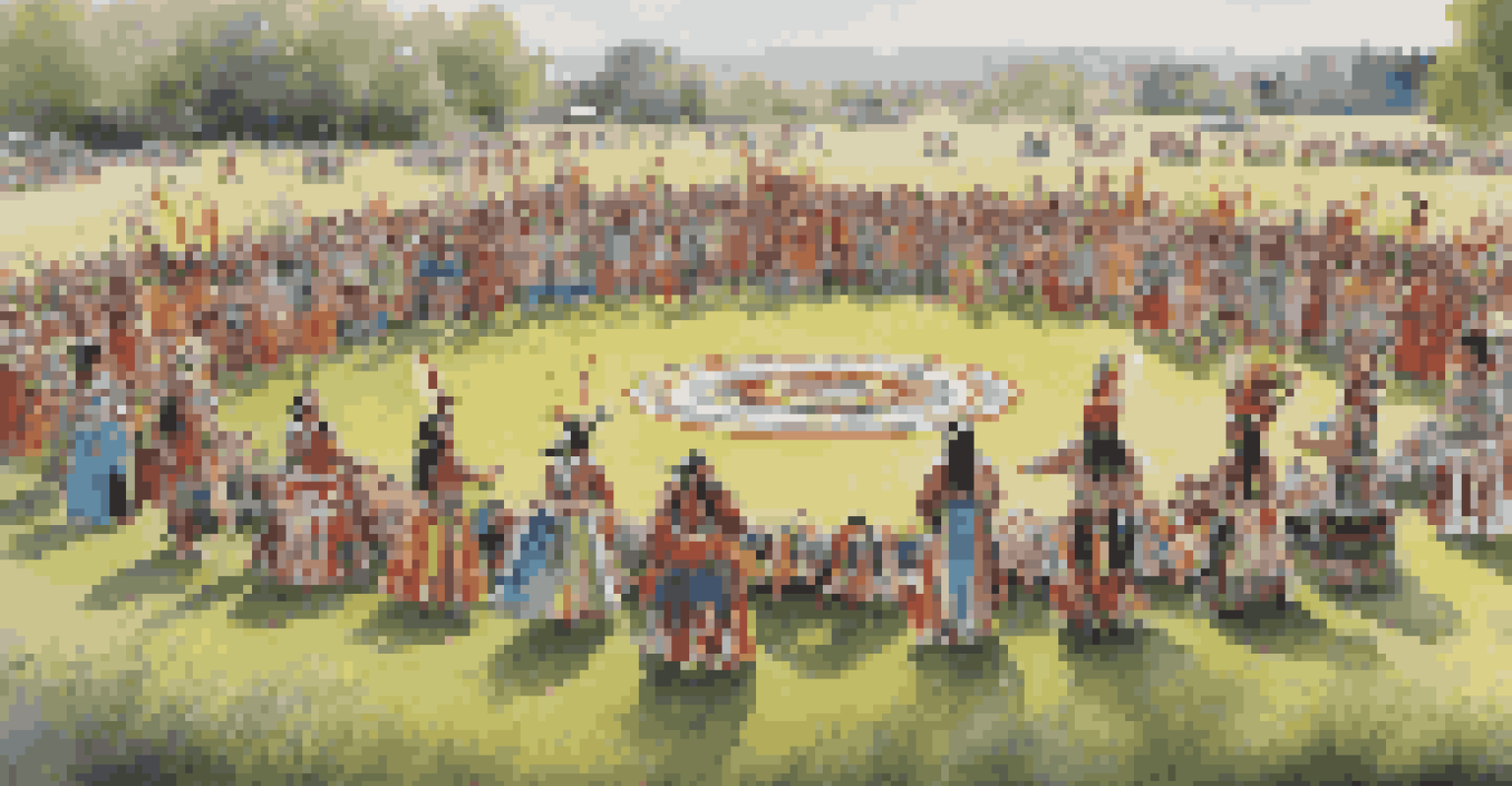Cultural Dance Traditions and Their Environmental Messages

The Dance of Nature: Understanding Cultural Expressions
Cultural dance is often a vibrant expression of community values and beliefs, intertwined with the natural world. Each movement, rhythm, and costume can reflect a deep connection to the environment, showcasing the beauty and significance of nature. For instance, the traditional hula of Hawaii is not just a dance; it narrates stories of the land and sea, emphasizing respect for the environment and the elements that sustain life.
Dance is the hidden language of the soul.
In many cultures, dance serves as a medium to celebrate seasonal changes, agricultural cycles, and ecological balance. This connection is evident in the way certain dances mimic natural movements, such as the swaying of trees in the wind or the flowing of water in rivers. By embodying these elements, dancers communicate an understanding of the symbiotic relationship between humans and nature.
Moreover, these performances often invoke a sense of responsibility, reminding communities of their role in preserving the environment. Just as a dance is a collaboration of movements, so too is our relationship with nature—a partnership that requires respect, care, and harmony.
Indigenous Dances: Honoring the Land and Its Spirits
Indigenous dances are deeply rooted in the history and spirituality of a community, often reflecting a profound reverence for the land. These performances frequently honor the ancestors and the spirits of nature, reinforcing a message of stewardship over the environment. For example, the Native American Powwow includes dances that celebrate the earth and its gifts, emphasizing a bond with the natural world.

The rhythms and movements in these dances often mirror the cycles of nature, portraying themes of growth, harvest, and renewal. Through storytelling, dancers illustrate the importance of living in harmony with the environment, conveying lessons passed down through generations. These dances serve as a reminder that every action has a ripple effect on the ecosystem.
Dance as Environmental Advocacy
Cultural dances serve as a powerful medium to express community values and raise awareness about environmental issues.
By showcasing their cultural heritage through dance, indigenous communities advocate for environmental protection and sustainability. Their performances resonate beyond the dance floor, prompting discussions about conservation and the need to honor traditional ecological knowledge.
Celebratory Dances: Fostering Eco-Consciousness
Many celebratory dances around the world often incorporate themes of nature, creating a joyful yet poignant awareness of environmental issues. For instance, the vibrant Carnaval in Brazil features dances that celebrate biodiversity and the Amazon rainforest, highlighting the importance of conservation. Through colorful costumes and lively music, these performances foster a collective consciousness about the environment.
The earth has music for those who listen.
In these dances, the message is clear: the health of the planet is worth celebrating. Participants often use their platform to advocate for environmental awareness, turning joyous festivities into educational moments. By intertwining dance with activism, communities can inspire change and mobilize support for eco-friendly initiatives.
Celebratory dances serve as a reminder that protecting the environment can be a joyous endeavor, bringing communities together to appreciate the beauty of nature. This integration of celebration and conservation encourages a deeper appreciation for the world around us.
Ritual Dances: Connecting Spirituality and Ecology
Ritual dances are often performed during significant cultural events, where the dance itself becomes a prayer to the earth. These performances can invoke blessings for a good harvest or express gratitude for natural resources. For example, the Rain Dance of various Native American tribes emphasizes the need for rain, highlighting the vital role water plays in sustaining life.
Through these ritualistic movements, participants connect with the spiritual essence of nature, reinforcing the belief that humans and the environment are interconnected. The act of dancing becomes a sacred ritual that honors the earth and its elements, fostering a sense of responsibility towards ecological stewardship.
Indigenous Dances and Stewardship
Indigenous dances highlight a deep reverence for nature, emphasizing the importance of ecological stewardship and sustainable practices.
Ritual dances remind us that spirituality and ecology are not separate realms but are intertwined. They invite participants and observers alike to reflect on their relationship with the environment and commit to protecting it.
Contemporary Dance: A Modern Take on Environmental Issues
Contemporary dance has emerged as a powerful medium for addressing pressing environmental issues. Choreographers and dancers are increasingly using their art to highlight climate change, deforestation, and pollution, blending creativity with activism. Performances often incorporate multimedia elements, creating a visceral experience that resonates with audiences on multiple levels.
Dances that focus on environmental themes provoke thought and inspire action, pushing viewers to reconsider their impact on the planet. For instance, productions like 'The Green Dance' use movement to depict the struggle against environmental degradation, leaving a lasting impression on all who witness it. This modern approach to dance serves as a rallying cry for ecological awareness.
By integrating contemporary dance with environmental advocacy, artists can reach diverse audiences, sparking conversations about sustainability. The stage becomes a platform for change, illustrating the power of movement to inspire and educate.
Dance Festivals: A Global Platform for Environmental Dialogue
Dance festivals around the world often serve as a melting pot of cultures, showcasing traditional and contemporary performances that celebrate the environment. These events provide a unique opportunity for artists to share their messages regarding ecological preservation and sustainability. Festivals like the Edinburgh Festival Fringe feature performances that tackle environmental themes, encouraging dialogue among diverse audiences.
At these gatherings, dance becomes a universal language, transcending cultural boundaries and uniting people in a shared vision for the future. Performers often engage with attendees, discussing the significance of their dances and the environmental messages behind them. This interaction fosters a deeper understanding of how cultural traditions can inspire ecological consciousness.
The Future of Dance and Activism
The evolution of dance is increasingly intertwined with environmental advocacy, inspiring a collective commitment to sustainability through artistic expression.
Dance festivals not only celebrate artistic expression but also amplify the voices of those advocating for the planet. They create a sense of community among artists and audiences, all committed to protecting the earth for future generations.
The Future of Dance: Bridging Culture and Environmental Action
As we look to the future, the intersection of dance and environmental advocacy continues to evolve. Artists are increasingly recognizing their role as environmental stewards, utilizing their platforms to raise awareness and inspire action. Through collaborative projects that combine dance with environmental science, the potential for impactful storytelling is limitless.
Future generations of dancers will likely draw upon their cultural heritage while also incorporating contemporary environmental challenges into their performances. This blending of the old and new can create powerful narratives that resonate with audiences and encourage a collective commitment to sustainability. Dancers become ambassadors for the environment, using their art to inspire change on a global scale.

By fostering a culture of environmental consciousness through dance, we can encourage more individuals to engage with and protect the planet. The future of dance is not only about artistic expression but also about forging a path toward a more sustainable world.